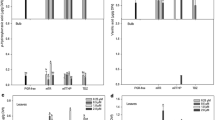Abstract
Podophyllum peltatum is an important medicinal plant that produces podophyllotoxin (PTOX) with anti-cancer properties. We established the embryogenic cell and adventitious root culture systems in P. peltatum and analyzed PTOX production. For the growth of embryogenic cell clumps in shake flask culture, the most efficient concentration of 2,4-dichloroacetic acid (2,4-D) was 6.78 μM, and the growth of embryogenic cell clumps was 15.9-fold increased in Murashige and Skoog MS liquid medium with 6.78 μM 2,4-D after 3 wk of culture. To induce adventitious roots, half-strength MS medium showed the best results for adventitious root induction compared to full strength MS medium and MS medium lacking NH4NO3. Optimal indole-3-butyric acid concentration for adventitious root formation was 14.78 μM. In liquid medium, the frequency of adventitious root formation from root segments was 87.7% and the number of laterally formed adventitious roots was 22.3 per segment. PTOX production in embryogenic cells and adventitious roots was confirmed by liquid chromatography and electrospray ionization–tandem mass spectrometry analysis. High-performance liquid chromatography analysis revealed that adventitious roots contained higher PTOX than embryogenic cell clumps. Elicitor treatment (20 μM methyl jasmonate) strongly enhanced the production of PTOX in both embryogenic cell clumps and adventitious roots. This observation suggests that both embryogenic cell and adventitious root culture can be adopted to produce PTOX.




Similar content being viewed by others
References
Arumugam N.; Bhojwani S. S. Somatic embryogenesis in tissue cultures of Podophyllum hexandrum. Can J Bot 68: 487–491; 1990.
Badhwar R. L.; Sharma B. K. A note on the germination of Podophyllum seeds. Indian Forest 89: 445–447; 1963.
Bastos J. K.; Burandt C. L.; Dhammika N. P.; Bryant L.; McChesney J. D. Quantization of aryltetralin lignans in plant parts and among different populations of Podophyllum peltatum by reversed-phase high-performance liquid chromatography. J Nat Prod 59: 406–408; 1996.
Chattopadhyay S.; Srivastava A. K.; Bhojwani S. S.; Bisaria V. S. Production of podophyllotoxin by plant cell cultures of Podophyllum hexandrum in bioreactor. J Biosci Bioeng 93: 215–220; 2002.
Choi Y. E.; Kim Y. S.; Paek K. Y. Types and designs of bioreactors for hairy root culture. In: GuptaS. D.; IbarakiY. (eds) Plant tissue culture engineering. Dordrecht, Springer, pp 161–172; 2006.
Damayanthi Y.; Lown J. W. Podophyllotoxins: current status and recent developments. Curr Med Chem 5: 205–252; 1998.
Foster S. Medicinal plant conservation and generic resources: examples from the temperate northern hemisphere. Acta Hort 330: 67–73; 1993.
Han J. Y.; Jung S. J.; Kim S. W.; Kwon Y. S.; Yi M. J.; Yi J. S.; Choi Y. E. Induction of adventitious roots and analysis of ginsenoside content and the genes involved in triterpene biosynthesis in Panax ginseng. J Plant Biol 49: 26–33; 2006.
Heyenga A. G.; Lucas J. A.; Dewick P. M. Production of tumour-inhibitory lignans in callus cultures of Podophyllum hexandrum. Plant Cell Rep 9: 382–385; 1990.
Jackson D. E.; Dewick P. M. Aryltetralin lignans from Podophyllum hexandrum and Podophyllum peltatum. Phytochemistry 23: 1147–1152; 1984a.
Jackson D. E.; Dewick P. M. Biosynthesis of Podophyllum lignans—II. Interconversions of aryltetralin lignans in Podophyllum hexandrum. Phytochemistry 23: 1037–1042; 1984b.
Karlsson S. B.; Vassil I. K. Morphology and ultrastructure of embryogenic cell suspension cultures of Panicum maximum (Guinea grass) and Pennisetum purpureum (Napier grass). Amer J Bot 73: 894–901; 1986.
Kadkade P. G. Growth and podophyllotoxin production in callus tissues of Podophyllum peltatum. Plant Sci Lett 25: 107–115; 1982.
Kim Y. S.; Lim S.; Choi Y. E.; Anbazhagan V. R. High frequency plant regeneration via somatic embryogenesis in Podophyllum peltatum L., an important medicinal plant for source of anticancer drug. Curr Sci 92: 662–666; 2007.
Moraes R. M.; Bedir E.; Barrett H.; Burandt C. Jr.; Canel C.; Khan I. A. Evaluation of Podophyllum peltatum accession for podophyllotoxin production. Planta Med 68: 341–344; 2002.
Murashige T.; Skoog F. A revised medium for rapid growth and bioassays with tobacco tissue cultures. Physiol Plant 15: 473–497; 1962.
Petersen M.; Alfermann A. W. The production of cytotoxic lignans by plant cell cultures. Appl Microbiol Biotechnol 55: 135–142; 2001.
Smollny T.; Wichers H.; Kalenberg S.; Shahsavari A.; Petersen M.; Alfermann A. W. Accumulation of podophyllotoxin and related lignans in cell suspension cultures in Linum album. Phytochemistry 49: 975–979; 1998.
Stähelin H. F.; von Wartburg A. The chemical and biological route from podophyllotoxin glucoside to etoposide: ninth Cain memorial Award lecture. Cancer Res 51: 5–15; 1991.
Rust R. W.; Roth R. R. Seed production and seedling establishment in the mayapple, Podophyllum peltatum L. Amer Midl Nat 105: 51–60; 1981.
Sasaki K.; Shimomura K.; Kamada H.; Harada H. IAA metabolism in embryogenic and nonembryogenic carrot cells. Plant Cell Physiol 35: 1159–1164; 1994.
Schmitt J.; Petersen M. Influence of methyl jasmonate and coniferyl alcohol on pinoresinol and matairesinol accumulation in Forsythia x intermedia suspension culture. Plant Cell Rep 20: 885–889; 2002.
van Fürden B.; Humburg A.; Fuss E. Influence of methyl jasmonate on podophyllotoxin and 6-methoxypodophyllotoxin accumulation in Linum album cell suspension cultures. Plant Cell Rep 24: 312–317; 2005.
van Uden W.; Pras N.; Visser J. F.; Malingré T. M. Detection and identification of Podophyllotoxin produced by cell cultures derived from Podophyllum hexandrum Royle. Plant Cell Rep 8: 165–168; 1989.
Acknowledgements
The authors thank Dr. Young-Rim Jung (Central Laboratory of Kangwon National University) for LC–ESI–MS/MS analysis. V. R. A. and E. H. are the recipients of a visiting scientist fellowship and Brain Pool program (KRF, South Korea), respectively. This work was supported by grant from the Korea Research Foundation (KRF-07-C00553).
Author information
Authors and Affiliations
Corresponding author
Additional information
Editor: Gregory C. Phillips
Rights and permissions
About this article
Cite this article
Anbazhagan, V.R., Ahn, C.H., Harada, E. et al. Podophyllotoxin production via cell and adventitious root cultures of Podophyllum peltatum . In Vitro Cell.Dev.Biol.-Plant 44, 494–501 (2008). https://doi.org/10.1007/s11627-008-9134-1
Received:
Accepted:
Published:
Issue Date:
DOI: https://doi.org/10.1007/s11627-008-9134-1




